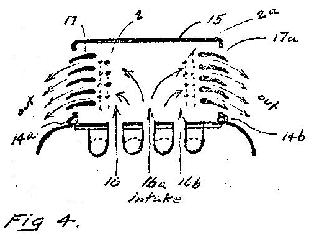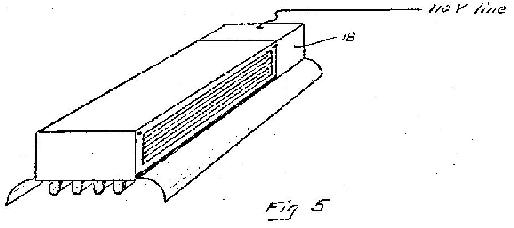"Lighting Fixture Incorporating Electrokinetic Precipitation
and Loudspeaker Apparatus"
(Return to Index Page)
Docket number 8319
Thomas Townsend Brown
1001 3rd Street
Santa Monica, CA 90403
Copyrighted © by The Townsend Brown family. All rights reserved.


 Comments
Comments:
1) Invention relates to the combination of lighting fixture and electrogasdynamic apparatus for
precipitation of smoke, pollen and dirt.
2) Invention relates to the combination of lighting fixture and electrogasdynamic loudspeaker.
This application is intended to cover lighting fixtures in general, but for sake of clarity,
ceiling fixtures are specifically referred to. In the same way, the application may cover
incandescent lighting, although fluorescent lighting fixtures are referred to in the drawings.
This application, so far as the structure of the self-propelling electrostatic precipitator is
concerned, relates to the applicant's US Patent No. 2,949,550 and two co-pending applications,
Docket Nos. 8318 and 8308. Precipitators may have two or three principal electrodes, any or all
of which may be removable for cleaning or replacement.
Precipitation louvres are removable for cleaning or are disposable. Inexpensive paper or plastic
plates are utilized. These plates are metallized or made ellectrically-conductive except for
the handle.
This application also relates to the applicant's US Patent No. 3,018,394 "Electrokinetic
Transducer." In so far as the production of sound is concerned, lighting fixtures serving also
as loudspeakers would appear to be useful in large offices or factories for "wired music" or
voice annunciation.
Four-tube fluorescent fixtures are indicated in the following drawing. The lamp base housing
is slightly enlarged to provide for the electrokinetic elements. Air is drawn into the housing
on one side or at the bottom and clean air vented out the opposite side.
This invention therefore, features a combination (fluorescent tube) lighting fixture with base
housing containing electrostatic precipitation apparatus with removable washable or disposable
collector plates.
The invention further features precipitation apparatus, which can be electro-kinetically
modulated so as to served as an electroacoustic transducer or loudspeaker.
In general, it is the object of the invention to provide a lighting fixture, especially a
ceiling fixture, for use in offices or commercial or industrial applications, where it is
desirable to provide smoke-free air and music or annunciator capability along with overhead
lighting. An advantage results from the fact that both the precipitator and loudspeaker are
operative only when the light is on.
Again, Mr. Kovelman, this is not an easy type of patent application for me to write. There is
nothing technically basic about it. Its value as af patent seems (to me) to reside largely in
its immediate commercial application as a combination unit. Undoubtedly there are many
manufacturers of commercial fluorescent lighting fixtures that would be interested in
manufacturing and marketing this combination device.
A patent application separate and distinct from my other patents would be helpful in defining
the scope of the license.
 Referring to the attached drawings
Referring to the attached drawings:
Fig. 1 is a circuit diagram of the simplest form of the speaker-precipitator.
Fig. 2 is a similar circuit diagram producing a two-dimensional air flow pattern.
Fig. 3 is a cross-section of a lighting fixture employing the circuit set forth in Fig. 1.
Fig. 4 is a cross-section of a similar lighting fixture using the circuit set forth in Fig. 2.
Fig. 5 is a prospective view of the typical commercial lighting fixture showing fluorescent
lamps in a housing containing the precipitator-transducer elements and power supply.
 Referring in detail to the attached drawings
Referring in detail to the attached drawings:
Fig. 1 shows louvres (1), which may or may not have adjustable angles and which preferably
have a streamlined slightly curved form with rounded leading edge (as indicated). Ionizer
wires (2) made of tungsten stainless steel or the like approximately .002" in diameter are
positioned midway between the leading edges of louvres (1) and slightly upstream therefrom.
This distance is a function of the high voltage applied theirbetween. Power supply (3)
provides DC potential difference between electrodes (1) and (2) resistor (4) acts as a current
limiting protective device and at the same time permits voltage variations of electrode (2)
through capacitor (5) from the secondary of modulation transformer (6). The input signal is
applied to the primary of transformer (6).

The potential difference between electrodes (1) and (2) provides a steady flow of air as
indicated by the arrows. Suspended particulate matter is precipitated on electrode (1).
Variations in the potential between electrodes (1) and (2) generates sound waves which travel
outward between the louvres of electrode (1) and outward in the same direction as the air flow.
Fig. 2 illustrates a circuit using a vacuum tube to modulate the signal input. The system
consists of louvres (1) and (1a), ionizer wires (2) and (2a) and control grids (7) and (7a).
High voltage is provided by power supply (3) with resistor (4) serving as a current
limiting device. Modulation signal is provided to the grid of vacuum tube triode (8) and the
varying plates potential supplied through resistor (9) is conducted to control grids (7) and
(7a). This circuit is shown in more detail in the applicant's co-pending application Docket No.
8308.

Fig. 3 is a cross-section of a lighting fixture with precipitator speaker installed in
the housing thereof. Louvres (1) and electrodes (2) serve the same purpose as in the previous
figures. Louvre (10) is located on the inlet side of the device and serves only to physically
protect electrode (2) without being included in electrical circuit. For flourescent (11, 11a,
11b, and 11c) are shown attached to the precipitator housing (12). It is to be understood that
louvres (1) can be removed for cleaning or they may be made of a cheap plastic material
metallized for conductivity, which are disposable. To facilitate removing, fastening (13) and
detachable hinges (14) permit the entire louvres section to swing down and be disengaged.

Fig. 4 shows housing (15) with inlet openings (16, 16a and 16b) to permit the flow of air
upward into the central chamber of housing (15). Air is propelled outward from highly charged
electrodes (2 and 2a) forward and through electrically grounded louvres (17 and 17a) upon
which the smoke particles and dirt are precipitated. These louvres are removable
for cleaning and or replacement by disengaging hinges (14a and 14b) in a manner similar to
that shown in Fig. 3.

Fig. 5 shows a standard commercial for lamp fluorescent fixture with housing such as that
described in figure four. But with a closed compartment, 18 at one end thereof to House power
supply and modulation components.

The lighting fixture shown in Fig. 5 merely refers to a popular class of commercial
fixtures and in no way is intended to limit the form or scope of the lighting fixtures
described herein. It is apparent that the combination of precipitator speaker and lighting
fixture may apply as well to incandescent fixtures for ceiling wall or even portable
applications. While specific details have been referred to the purpose of imparting a clear
understanding of a combination lighting fixture precipitator-loudspeaker, it is clear that many
styles of fixtures may be resorted to without departing from the spirit of the invention as
intended to be covered in the following claims.
 I Claim
I Claim:
1) The combination in a lighting fixture of the light source and electrokinetic transducer
precipitator or elements comprising sets of electrodes of different surface area, means for
supplying different electrical potentials to said sets of electrodes, and means to modulate
set potentials.
2) A lighting fixture containing a light source in combination with electrokinetic apparatus for
concurrently cleaning air and serving as a loudspeaker comprising electrodes of different
surface area, means for supplying different electrical potentials to said electrodes, means to
modulate said potentials, and means for removing said electrodes for cleaning.
3) Apparatus, according to Claim 2 wherein said electrodes may be disposable and replaceable.
Thomas Townsend Brown
Santa Monica, California
June 23, 1967
 Addendum
Addendum:
Since patentability of a combination depends upon a new and "unexpected" result being achieved
by the combination, attention should be given to the following technical facts:
1) Photoelectric Effects:
Both the electrostatic precipitator and the electrokinetic loudspeaker (as set forth in the
present patent application) depend upon high ionization of air. The effectiveness is largely
determined by the ionization threshold of air, and this value should be as low as possible.
To facilitate high ionization at the lowest possible voltage, the electrodes are coated with
emissive materials, many of which are photoelectric.
The presence, therefore, of an exciting radiation actively increases the emissivity of these
coatings, and improves the operation of the electrokinetic devices.
In short, both the visible in the near ultraviolet light from the lighting fixture improves the
operation of the electrokinetic components of the combination.
2) Reduction of Ozone:
A further advantage is gained, particularly when using fluorescent lamps, by the action of
radiation in the region of 2500 to 2600 Angstroms in decomposing ozone.
This is especially useful in those instances were even a small amount (less than 3 parts per
hundred million) of ozone may be objectionable.
In short, the radiation from fluorescent lamps entering the precipitation chamber through the
air intake ports, serves also to eliminate even a small amount of ozone which may be generated.
It is to be pointed out, therefore, that the combination lighting fixture and electrokinetic
precipitator and loudspeaker accomplishes a result, which cannot be achieved by the components
operating separately. For this reason, the combination appears to have the necessary
qualifications for patentability.
Thomas Townsend Brown
Santa Monica, California


 Please be advised that this document is copyrighted © by The Townsend Brown family. All rights reserved.
Please see Legal and Copyright Information for additional copyright information.
Please be advised that this document is copyrighted © by The Townsend Brown family. All rights reserved.
Please see Legal and Copyright Information for additional copyright information.







